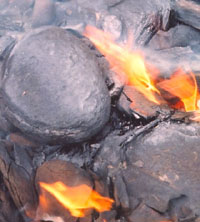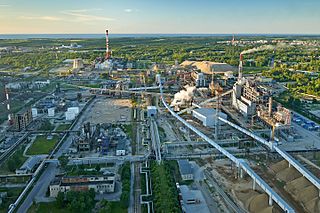
Kyrgyzstan is a mountainous country with a dominant agricultural sector. Cotton, tobacco, wool, and meat are the main agricultural products, although only tobacco and cotton are exported in any quantity. According to Healy Consultants, the economy relies heavily on the strength of industrial exports, with plentiful reserves of gold, mercury, uranium and natural gas. The economy also relies heavily on remittances from foreign workers. Following independence, Kyrgyzstan was progressive in carrying out market reforms, such as an improved regulatory system and land reform. Kyrgyzstan was the first Commonwealth of Independent States (CIS) country to be accepted into the World Trade Organization. Much of the government's stock in enterprises has been sold. Kyrgyzstan's economic performance has been hindered by widespread corruption, low foreign investment and general regional instability. Despite political corruption and regional instability, Kyrgyzstan is ranked 70th on the ease of doing business index.

Oil shale is an organic-rich fine-grained sedimentary rock containing kerogen from which liquid hydrocarbons can be produced, called shale oil. Shale oil is a substitute for conventional crude oil; however, extracting shale oil from oil shale is more costly than the production of conventional crude oil both financially and in terms of its environmental impact. Deposits of oil shale occur around the world, including major deposits in the United States. A 2016 estimate of global deposits set the total world resources of oil shale equivalent of 6.05 trillion barrels of oil in place.

The Shell's in situ conversion process is an in situ shale oil extraction technology to convert kerogen in oil shale to shale oil. It is developed by the Shell Oil Company.

Eesti Energia AS is a private limited energy company in Estonia with its headquarters in Tallinn. It is the world's biggest oil shale to energy company. The company was founded in 1939. As of 2014, it operates in Estonia, Latvia, Lithuania, Finland, Jordan and Utah, United States. In Estonia the company operates under the name Eesti Energia, while using the brand name Enefit for international operations. The main raw material for energy production – oil shale – is extracted from mines located in Eastern-Estonia and owned by the company. The group of Eesti Energia has three main operation areas: electricity generation, shale oil production, and sale and distribution electricity. Its shares are owned by the Government of Estonia.

Energy in Bulgaria describes energy and electricity production, consumption and trade in Bulgaria.
Viru Keemia Grupp (VKG) is an Estonian holding group of oil shale industry, power generation, and public utility companies.
Oil shale reserves refers to oil shale resources that are economically recoverable under current economic conditions and technological abilities. Oil shale deposits range from small presently economically unrecoverable to large potentially recoverable resources. Defining oil shale reserves is difficult, as the chemical composition of different oil shales, as well as their kerogen content and extraction technologies, vary significantly. The economic feasibility of shale oil extraction is highly dependent on the price of conventional oil; if the price of crude oil per barrel is less than the production price per barrel of shale oil, it is uneconomic.

The oil shale industry is an industry of mining and processing of oil shale—a fine-grained sedimentary rock, containing significant amounts of kerogen, from which liquid hydrocarbons can be manufactured. The industry has developed in Brazil, China, Estonia and to some extent in Germany and Russia. Several other countries are currently conducting research on their oil shale reserves and production methods to improve efficiency and recovery. Estonia accounted for about 70% of the world's oil shale production in a study published in 2005.

The Stuart Oil Shale Project is an oil shale development project in Yarwun near Gladstone, Queensland, Australia. It is Australia's first major attempt since the 1950s to restart commercial use of oil shale. The project was originally developed by Australian companies Southern Pacific Petroleum NL and Central Pacific Minerals NL (SPP/CPM) and developed now by Queensland Energy Resources. The original facility built at the end of the 1990s was dismantled and the new demonstration facility started its operations in 2011.

The history of the oil shale industry started in ancient times. The modern industrial use of oil shale for oil extraction dates to the mid-19th century and started growing just before World War I because of the mass production of automobiles and trucks and the supposed shortage of gasoline for transportation needs. Between the World Wars oil shale projects were begun in several countries.
The mineral industry of Russia is one of the world's leading mineral industries and accounts for a large percentage of the Commonwealth of Independent States' production of a range of mineral products, including metals, industrial minerals, and mineral fuels. In 2005, Russia ranked among the leading world producers or was a significant producer of a vast range of mineral commodities, including aluminum, arsenic, cement, copper, magnesium compounds and metals, nitrogen, palladium, silicon, nickel and vanadium.
The Kandym–Khausak–Shady–Kungrad project is a project to develop natural gas fields in Uzbekistan. The project is carried out by consortium of Lukoil (90%) and the Uzbekneftegaz (10%).
Oil shale in China is an important source of unconventional oil. A total Chinese oil shale resource amounts of 720 billion tonnes, located in 80 deposits of 47 oil shale basins. This is equal to 48 billion tonnes of shale oil. At the same time there are speculations that the actual resource may even exceed the oil shale resource of the United States.

Oil shale in Jordan represents a significant resource. Oil shale deposits in Jordan underlie more than 70% of Jordanian territory. The total resources amounts to 31 billion tonnes of oil shale.
Uzbekistan GTL is a planned gas-to-liquids (GTL) project based in southern Uzbekistan. It is expected to be the 3-rd biggest GTL-factory in the world.
Energy in Indonesia describes energy and electricity production, consumption, import and export in Indonesia. In 2009 Indonesia produced oil, coal, natural gas and palm oil, utilised also as energy raw material in 2010. Renewable energy potential in Indonesia is high: solar, wind, hydro and geothermal energy. Tropical rain forests and peat land areas have extensive coal storage. Indonesia is a geologically unstable country. According to IEA Indonesia was the 10th top natural gas producer in 2009: 76 billion cubics (bcm) 2.5% of world production of which 36 bcm was exported. In 2009 Indonesia was the 5th top coal producer: 263 million tonnes hard coal and 38 million tonnes brown. The majority of this, 230 Mt of hard coal, was exported. Indonesia has significant energy resources, starting with oil – it has 22 billion barrels of conventional oil and gas reserves, of which about 4 billion are recoverable. That's the equivalent of about 10 years of oil production and 50 years of gas. It has about 8 billion barrels of oil-equivalent of coal-based methane (CBM) resources. It has 28 billion tonnes of recoverable coal and has 28 gigawatts (GW) of geothermal potential.

Oil shale in Israel is widespread but an undeveloped resource, largely because of economic and technological constraints. Israeli oil shales belong to the group of Upper Cretaceous marinites. Although oil-shale deposits may lie under as much as 15% of the country, only a small part of these are mineable. According to the Geological Survey of Israel, deposits that could have the biggest economic potential are located in the northern Negev, the largest being the Rotem-Yamin formation. For several decades, oil shale was used for small-scale power generation at Mishor Rotem. Several Israeli companies have proposed shale oil extraction; testing of the viability of the oil shale industry is currently being undertaken by Israel Energy Initiatives. However, as of 2011, there are no commercial oil shale operations in Israel.
There are oil shale deposits in Australia which range from small deposits to large reserves. Deposits, varying by their age and origin, are located in about a third of eastern Australia. In 2012, the demonstrated oil shale reserves were estimated at 58 billion tonnes. The easiest to recover deposits are located in Queensland.













